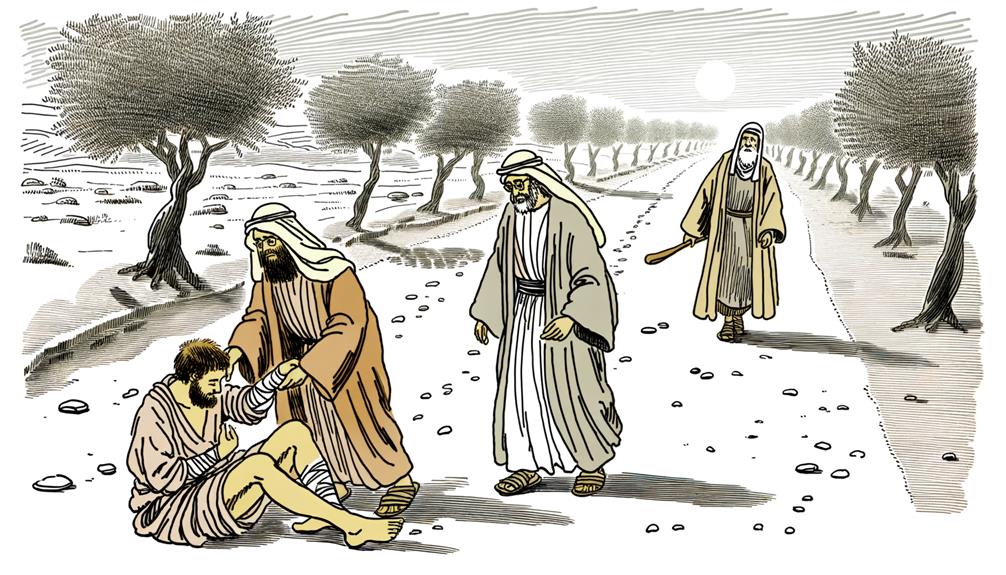Meaning of Good Samaritan in the Bible: Compassion
In the Bible, the Good Samaritan’s parable, found in Luke 10:25-37, challenges deep-seated enmity between Jews and Samaritans by highlighting radical neighborly love. When a lawyer questions Jesus about who qualifies as a neighbor, Jesus recounts the story of a Samaritan who, unlike a priest and Levite, aids a wounded traveler.
This act of mercy transcends ethnic and cultural prejudices of first-century Judea, emphasizing that true neighborliness involves compassion and tangible acts of kindness. The parable urges us to embrace an inclusive, empathetic approach to others, revealing profound theological and ethical implications.
Explore how this narrative continues to shape our principles today.

The Biblical Meaning of the Good Samaritan: A Symbol of Compassion, Love, and Selfless Service
| Aspect | Biblical Meaning | Scriptural Significance |
|---|---|---|
| Compassion for All People | The Good Samaritan story emphasizes the importance of showing compassion and kindness to everyone, regardless of their background or social status. | Found in Luke 10:25-37, where the Samaritan helps a wounded man, demonstrating love beyond cultural or religious boundaries. |
| Love Your Neighbor as Yourself | The parable highlights the commandment to love your neighbor, as the Samaritan goes out of his way to care for a stranger, embodying selfless love. | This fulfills the greatest commandment in Luke 10:27 to “love your neighbor as yourself.” |
| Breaking Cultural Barriers | The story teaches breaking cultural and racial prejudices, as Samaritans and Jews were historically at odds, yet the Samaritan showed kindness beyond these divisions. | Demonstrates Jesus’ teaching that love transcends racial, ethnic, or societal divisions. |
| Act of Selfless Service | The Samaritan’s actions show selfless service, putting the injured man’s needs above his own, including paying for his care and providing shelter. | Reflects the biblical call for believers to serve others with humility and generosity, found in Philippians 2:3-4. |
| God’s Call to Mercy | The parable illustrates the biblical principle of mercy, encouraging people to help those in need, even at personal cost or inconvenience. | This mirrors the teaching in Matthew 5:7, “Blessed are the merciful, for they will be shown mercy.” |
| Practical Faith in Action | The Good Samaritan’s actions show that true faith is demonstrated through acts of love and kindness toward others, not just through religious knowledge or rituals. | James 2:17 teaches that “faith by itself, if it is not accompanied by action, is dead,” emphasizing the importance of practical compassion. |
| Jesus’ Example of Love | The story is ultimately an illustration of the type of love that Jesus Himself shows, urging believers to follow His example in serving and loving others unconditionally. | Reflects Christ’s teachings on loving others, as He showed ultimate compassion through His life and sacrifice (John 13:34-35). |
Historical Context

To truly grasp the significance of the Good Samaritan parable, we must explore the historical tensions between Jews and Samaritans during the first century.
These two groups had deep-seated animosities stemming from religious and ethnic differences. Samaritans, considered heretics by Jews, worshipped on Mount Gerizim instead of Jerusalem. This division led to mutual hostility and even violence.
Knowing this background, Jesus’ choice of a Samaritan as the hero in the parable becomes radical. He challenges prevailing prejudices and calls His followers to transcend societal barriers.
By placing a despised Samaritan in a role of compassion, Jesus underscores that love and service should extend beyond ingrained biases.
This historical context enriches our understanding of the parable’s profound message.
The Lawyer’s Question

Recognizing the historical tensions between Jews and Samaritans, we see why the lawyer’s question, ‘Who is my neighbor?’ was so provocative. By questioning Jesus, the lawyer wasn’t merely seeking clarity; he was probing deeper societal and theological boundaries. His inquiry raised several key points:
- Legal Interpretations: It addressed the Jewish law’s stipulations about love and duty.
- Social Divisions: It highlighted the prevailing animosity and exclusion between different groups.
In this context, the lawyer’s question wasn’t just about defining a neighbor but also about confronting ingrained prejudices.
Understanding this backdrop helps us appreciate the radical nature of the parable that follows, urging us to re-evaluate our own perceptions and actions toward others.
Jesus’ Response
In Jesus’ response to the lawyer, He articulates the parable’s core message, emphasizing compassion over legalism.
By illustrating who the true neighbor is, Jesus redefines social and religious boundaries, urging us to act with mercy.
This narrative challenges us to see beyond legalistic interpretations and embrace the profound, inclusive love that defines the Kingdom of God.
Parable’s Core Message
Jesus’ response in the parable of the Good Samaritan emphasizes the universal call to love and show mercy, transcending cultural and religious boundaries. This core message challenges us to act compassionately toward all, regardless of societal divisions.
In the historical context of first-century Judea, Jews and Samaritans were bitter enemies, yet Jesus purposely chose a Samaritan as the compassionate figure. This choice underscores several theological points:
- Radical Inclusivity: God’s love extends beyond ethnic and religious lines.
- Active Compassion: True neighborliness involves tangible acts of kindness.
Compassion Over Legalism
Highlighting the tension between compassion and legalism, the parable illustrates how Jesus prioritized love and mercy over strict adherence to religious laws.
When the priest and Levite ignored the injured man, they followed legal purity codes.
Jesus, however, showed that true righteousness lies in acts of compassion.
Historically, Samaritans and Jews had deep-seated animosities, yet the Samaritan’s actions transcended these divides.
Jesus’ response invites us to see beyond legalistic boundaries and embrace a heart of mercy.
In doing so, He challenges us to serve others selflessly, even when cultural or religious norms suggest otherwise.
This parable calls us to embody God’s love, placing human need above ritualistic observance, thereby redefining what it means to be truly faithful.
Defining True Neighbor
By emphasizing the Samaritan’s compassionate actions, Jesus posed a profound question: ‘Which of these three do you think was a neighbor to the man who fell into the hands of robbers?’
This question shifts the focus from who qualifies as a neighbor to how one can act neighborly.
Jesus’ response invites us to:
- Embrace compassion: The Samaritan didn’t just see the man; he acted to help.
- Transcend boundaries: The Samaritan crossed ethnic and cultural lines.
In theological terms, Jesus redefines neighborliness as an active, merciful response to need, irrespective of social barriers.
This challenges us to serve others with an open heart, embodying divine love in practical ways.
Characters in the Parable

The parable of the Good Samaritan features several key characters: a traveler, robbers, a priest, a Levite, and a Samaritan, each representing distinct societal roles and moral lessons.
The traveler, a symbol of human vulnerability, falls victim to robbers who strip, beat, and leave him half-dead.
The priest and Levite, representing religious authority and duty, pass by without offering help, highlighting the failure of institutionalized piety.
The Samaritan, often despised by Jews, embodies unexpected compassion and true neighborly love.
By contrasting the actions of these characters, Jesus challenges us to transcend societal prejudices and embrace a universal ethic of love and mercy.
Each character’s role deepens our understanding of who our neighbor truly is, urging us to serve others selflessly.
Actions of the Samaritan

Seeing the wounded traveler, the Samaritan immediately steps in to provide aid, demonstrating an active and compassionate response that transcends cultural and religious barriers. His actions are a profound demonstration of mercy and love in the face of human suffering, reflecting the divine commandment to ‘love thy neighbor.’
- Bandaging wounds: He uses his resources to clean and bandage the man’s injuries, showing immediate physical care.
- Transporting to safety: Placing the traveler on his own animal, he guarantees the man reaches an inn for further care.
These actions underscore a holistic approach to compassion, embodying the essence of neighborly love.
Societal Norms Challenged

In the parable of the Good Samaritan, Jesus challenges societal norms by highlighting the compassion of a Samaritan, a group despised by Jews.
I see this as a profound call to prioritize love and mercy over ingrained prejudices.
Scripturally, it underscores the radical inclusivity of God’s kingdom, breaking cultural barriers and redefining neighborly love.
Breaking Cultural Barriers
Challenging societal norms, the parable of the Good Samaritan overturns deeply rooted cultural prejudices by illustrating a radical form of neighborly love. This story, found in Luke 10:25-37, highlights how Jesus defied the enmity between Jews and Samaritans.
By elevating the Samaritan as the hero, Jesus:
- Confronted ingrained societal and religious biases.
- Demonstrated that true love transcends ethnic and cultural boundaries.
In a time when Jews and Samaritans harbored mutual animosity, Jesus’ parable subverted expectations and beckoned His followers to embrace a more inclusive understanding of ‘neighbor.’
This transformative lesson compels us to reflect on our own prejudices and extend mercy beyond conventional limits.
Compassion Over Prejudice
Jesus’ depiction of the Good Samaritan powerfully asserts that genuine compassion must override societal norms and prejudices. When Jesus told this parable, the animosity between Jews and Samaritans was palpable, rooted in centuries of conflict and religious differences.
Yet, He chose a Samaritan as the hero, challenging His audience to see beyond ingrained biases. The Samaritan’s actions—tending to the wounds, offering shelter, and providing for the injured man’s care—embody the essence of agape love, a selfless, sacrificial love that transcends societal boundaries.
Jesus’ message is clear: to truly serve others, we must prioritize compassion over prejudice. By doing so, we reflect God’s unconditional love and foster a more inclusive, empathetic community.
Lessons on Compassion
The parable of the Good Samaritan teaches that true compassion transcends cultural and religious boundaries, urging us to act with kindness and mercy towards everyone.
In the biblical context, Samaritans were despised by Jews, yet it was a Samaritan who helped the injured man. This act of mercy challenges us to:
- Break societal norms: Compassion isn’t limited by societal prejudices.
- Embrace selflessness: The Samaritan’s actions reflect a self-giving love that expects nothing in return.
Theologically, this parable emphasizes that our neighbor is anyone in need, irrespective of their background.
Historically, it underscores the radical inclusivity Jesus preached, prompting us to serve all humanity with an open heart.
Modern Interpretations

In considering modern interpretations of the Good Samaritan, I see its principles reflected in everyday acts of kindness and the establishment of legal Good Samaritan laws.
These laws, inspired by the biblical narrative, aim to protect those who offer aid to others in distress.
Everyday Acts of Kindness
Modern interpretations of the Good Samaritan story often highlight how simple, everyday acts of kindness can embody the essence of Christian love and compassion.
Jesus’ parable teaches that our neighbor is anyone in need, regardless of societal divisions. By practicing small acts of kindness, we live out the gospel’s call to love one another.
- Offering a listening ear: Sometimes, the most profound gift we can give is our presence and attention.
- Assisting strangers: Helping someone with their groceries or offering directions can reflect Christ’s love.
Each act, though small, fulfills the Good Samaritan’s spirit, illustrating that true compassion transcends boundaries and manifests in daily life.
Legal Good Samaritan Laws
Good Samaritan laws, rooted in the biblical narrative, provide legal protection to those who offer aid in emergency situations, reflecting society’s recognition of the moral imperative to help others in distress. These laws derive their name from the parable of the Good Samaritan, where an individual extends compassion and assistance to a stranger in need. Historically, they serve as a bridge between ancient scriptural values and modern legal frameworks, emphasizing our collective responsibility to act selflessly.
| Country | Legal Protection Scope | Notable Provision |
|---|---|---|
| United States | Medical emergencies | Protects from liability unless grossly negligent |
| Canada | General emergency assistance | Covers both medical and non-medical aid |
| United Kingdom | First aid and rescue | Good faith requirement |
| Australia | Medical and non-medical aid | Encourages bystander intervention |
| Germany | Immediate danger assistance | Legal duty to assist |
In embracing these laws, we honor the scriptural call to serve others.
Relevance Today
As we navigate the complexities of contemporary society, the parable of the Good Samaritan challenges us to embody compassion and altruism in our daily lives. This ancient narrative, rooted in Jesus’ teachings, remains profoundly relevant. The story of the Good Samaritan reminds us of the importance of reaching out to those in need, regardless of race, religion, or social status. It serves as a call to action for us to look beyond our own self-interests and to actively seek opportunities to perform good deeds in Bible in the lives of others. In doing so, we can reflect the love and kindness that Jesus exemplified in his own life.
The Good Samaritan’s actions transcend cultural and religious boundaries, urging us to:
- Recognize the inherent dignity in every person, regardless of their background or status.
- Act selflessly, even when it’s inconvenient or costly, mirroring the Samaritan’s generosity.
In a world often fractured by division, this parable compels us to extend kindness and care beyond our immediate circles, aligning our lives with the gospel’s call to love our neighbors as ourselves.
Applying the Parable

In reflecting on the parable’s profound implications, we must discern how its lessons can be concretely manifested in our daily interactions and societal structures. The Good Samaritan challenges us to transcend cultural prejudices, embodying Christ’s call to love our neighbor. Historically, this parable disrupted Jewish-Samaritan animosity, urging us to extend compassion beyond our comfort zones. Scripturally, it underscores that mercy is paramount over ritualistic piety.
| Aspect | Application Example |
|---|---|
| Cultural Prejudices | Engaging in interfaith dialogues |
| Compassion | Volunteering at local shelters |
| Mercy over Rituals | Prioritizing kindness in conflicts |
| Societal Structures | Advocating for social justice |
| Daily Interactions | Offering help to strangers in need |
Conclusion
In reflecting on the Good Samaritan, I’m struck by its timeless call to love beyond boundaries.
Jesus’ parable, rich in historical context and deep scriptural meaning, challenges us to act with boundless compassion. It’s not just ancient wisdom; it’s a living mandate.
Today, we’re called to emulate that Samaritan, to see, to feel, to act. Isn’t that the essence of faith—to love as He loved, unconditionally?
Let’s embrace this parable’s enduring relevance in our daily lives.






